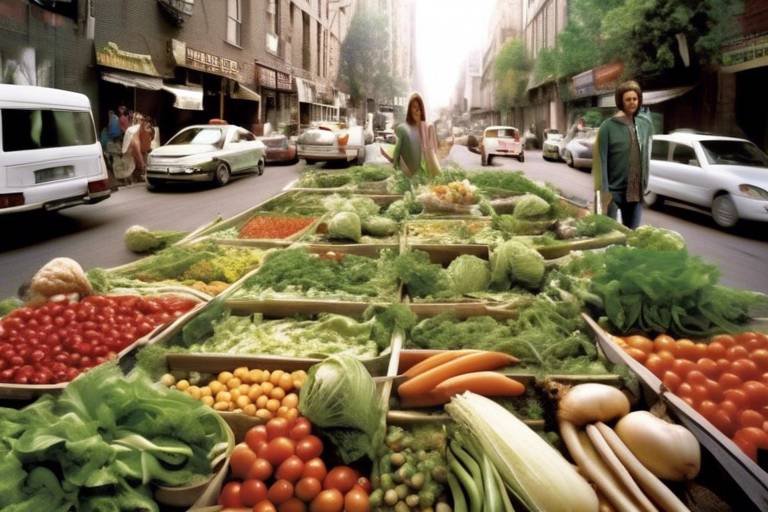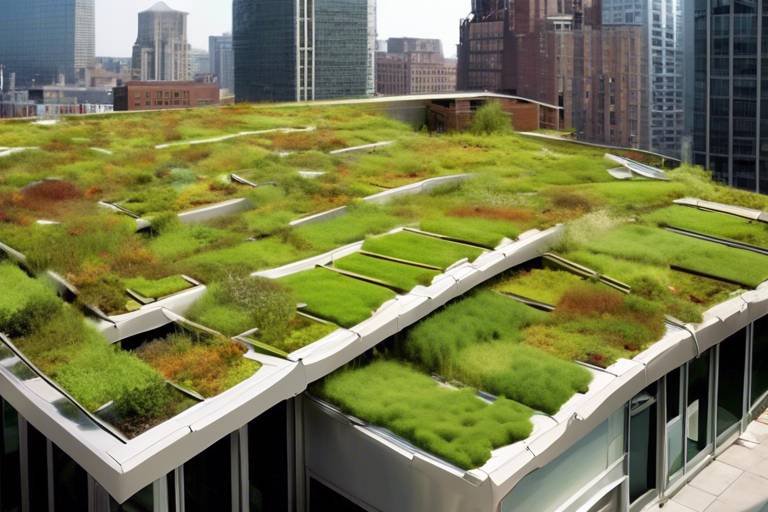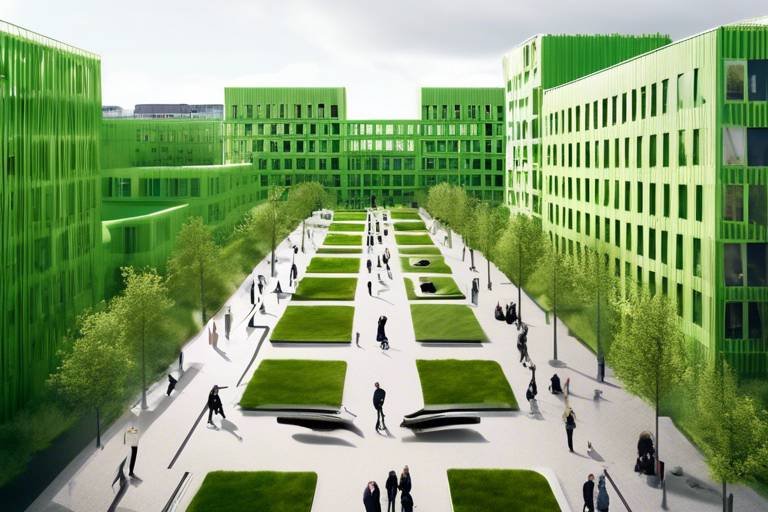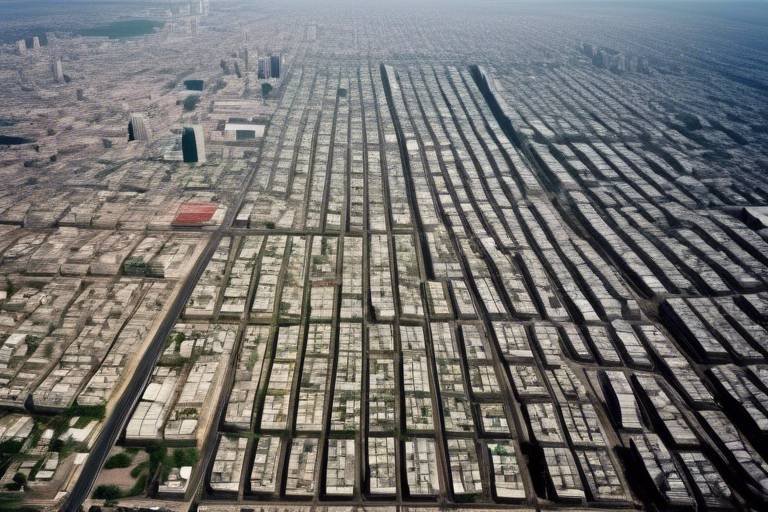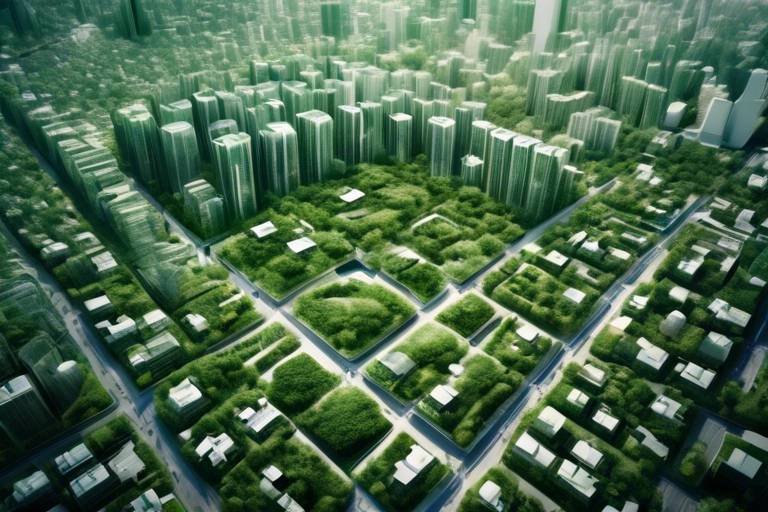Strategies to Promote Energy Efficiency in Urban Settings
This article explores various strategies that urban areas can implement to enhance energy efficiency, reduce waste, and promote sustainable practices among residents and businesses for a greener future.
Effective urban planning plays a crucial role in energy efficiency. By integrating green spaces and sustainable architecture, cities can significantly reduce energy consumption and improve residents' quality of life. Imagine walking through a neighborhood where trees line the streets, providing shade and reducing the need for air conditioning. Not only does this enhance the aesthetic appeal, but it also creates a healthier environment. Urban planners should prioritize the development of parks, community gardens, and green roofs, which can act as natural insulators and reduce the urban heat island effect.
The adoption of smart technologies can revolutionize energy management in urban environments. Devices like smart meters, IoT sensors, and advanced energy management systems enable real-time monitoring and optimization of energy use. For instance, smart meters can provide residents with detailed insights into their energy consumption patterns, allowing them to make informed decisions about their usage. By embracing these technologies, cities can create a more responsive energy grid that adjusts to demand in real-time, ultimately leading to significant savings and reduced carbon footprints.
Utilizing renewable energy sources such as solar, wind, and geothermal can drastically decrease urban reliance on fossil fuels. Cities can implement incentives for residents and businesses to adopt these technologies. For example, solar panels on rooftops not only generate clean energy but can also reduce electricity bills. The integration of wind turbines in suitable urban areas can harness natural wind currents to produce energy. This shift towards renewables is crucial for building a sustainable future.
Providing financial incentives for homeowners to install renewable energy systems encourages widespread adoption. Tax credits, rebates, and grants can make these technologies more accessible and appealing. By lowering the upfront costs, cities can motivate homeowners to invest in solar panels or energy-efficient appliances, leading to a collective reduction in energy consumption. Imagine the impact if every household in a city invested in renewable energy; the reduction in greenhouse gas emissions would be monumental.
Community solar initiatives allow multiple households to benefit from a single solar installation, making renewable energy accessible to those who cannot install systems on their own properties. This approach not only democratizes access to clean energy but also fosters a sense of community. Residents can come together to invest in solar farms, sharing the benefits and savings. It's like pooling resources to buy a ticket for a concert—everyone enjoys the show without bearing the full cost alone.
Enhancing public transportation systems can reduce the number of vehicles on the road, leading to lower emissions and energy consumption. Efficient transit options encourage residents to choose sustainable travel methods. Imagine a city where electric buses and trains run frequently and on time, making it easy for people to leave their cars at home. This not only reduces traffic congestion but also improves air quality, creating a healthier environment for all. Cities should invest in expanding and modernizing their public transit systems to make them more appealing and efficient.
Implementing stringent building codes that require energy-efficient designs can ensure that new constructions contribute to lower overall energy consumption, promoting sustainability in urban development. By mandating features such as improved insulation, energy-efficient windows, and sustainable materials, cities can pave the way for a future where buildings consume less energy and operate more sustainably. This is not just about compliance; it's about creating a culture of sustainability that permeates every aspect of urban life.
Retrofitting older buildings with energy-efficient technologies, such as better insulation and energy-efficient windows, can significantly reduce their energy usage and environmental impact. Many cities boast a rich architectural history, and retrofitting allows them to preserve this heritage while modernizing for energy efficiency. It's like giving an old classic car a new engine—keeping the charm while enhancing performance. By investing in these upgrades, cities can drastically cut down on energy waste and promote a greener future.
Engaging the community through education on energy-saving practices empowers residents to make informed choices, fostering a culture of sustainability that can lead to lasting change. Workshops, seminars, and informational campaigns can provide valuable resources and tips for reducing energy consumption at home. When residents understand the impact of their choices, they are more likely to participate in energy-saving initiatives. It's about creating a community that not only talks the talk but also walks the walk towards sustainability.
- What are some simple ways to improve energy efficiency at home?
Some simple ways include using LED bulbs, unplugging devices when not in use, and using energy-efficient appliances. - How can I get involved in community solar programs?
Check with local energy providers or community organizations to find out if there are any ongoing community solar initiatives in your area. - What incentives are available for installing renewable energy systems?
Many states offer tax credits, rebates, and grants for homeowners who install solar panels or wind turbines. It's best to check with local government websites for specific programs. - How does public transportation contribute to energy efficiency?
Public transportation reduces the number of individual cars on the road, which in turn lowers emissions and energy consumption, making cities more sustainable.

Urban Planning and Design
Effective urban planning is not just about laying out streets and buildings; it's a dynamic approach to creating spaces that enhance energy efficiency and improve the quality of life for residents. Imagine a city where green parks are not just an afterthought but a fundamental part of the design. When cities integrate green spaces and sustainable architecture, they don't just beautify the landscape; they create environments that significantly reduce energy consumption. Think about it: trees provide shade, which can lower the temperature of surrounding areas, reducing the need for air conditioning during those hot summer months. It's like nature's own air conditioning system!
Moreover, the design of buildings plays a critical role in how energy is consumed. By utilizing energy-efficient materials and designs, urban planners can ensure that new constructions contribute to a more sustainable future. For instance, buildings designed with natural lighting in mind can minimize the need for artificial lights, thus saving energy. Similarly, incorporating features like green roofs can help insulate buildings, keeping them cooler in the summer and warmer in the winter. This not only saves energy but also reduces the overall carbon footprint of the city.
Urban planning isn't just about the physical structures; it's about creating a community-oriented environment. When neighborhoods are designed to promote walking and cycling, they encourage residents to leave their cars at home. This not only reduces traffic congestion but also leads to lower emissions and healthier lifestyles. Imagine a community where everything you need is within walking distance—grocery stores, schools, parks—making it easy to choose sustainable travel methods. It's a win-win situation!
To illustrate the impact of urban planning on energy efficiency, consider the following table:
| Urban Design Element | Impact on Energy Efficiency |
|---|---|
| Green Spaces | Reduces heat islands, lowers cooling costs |
| Mixed-Use Development | Encourages walking, reduces vehicle dependency |
| Energy-Efficient Building Materials | Minimizes energy consumption for heating and cooling |
| Smart Infrastructure | Improves energy management and reduces waste |
In conclusion, urban planning and design are pivotal in shaping a sustainable future. By prioritizing energy efficiency in every aspect—from the layout of streets to the materials used in construction—cities can lead the way towards a greener, more sustainable world. The challenge lies in the hands of urban planners, architects, and communities to collaborate and create spaces that not only meet today's needs but also safeguard the environment for future generations.
- What is urban planning? Urban planning is the process of designing and regulating the use of land, resources, and infrastructure in urban areas to create sustainable communities.
- How does urban design impact energy efficiency? Urban design influences energy efficiency by determining the layout of buildings, transportation options, and green spaces, all of which affect energy consumption patterns.
- What are some examples of energy-efficient building materials? Examples include insulated concrete forms, energy-efficient windows, and sustainable wood products.
- How can communities engage in sustainable urban planning? Communities can participate by advocating for green spaces, supporting public transportation, and promoting energy-efficient practices.

Smart Technology Integration
In today’s fast-paced urban environments, the integration of smart technology is not just a luxury; it’s a necessity for promoting energy efficiency. Imagine a city where your thermostat knows when you're home and adjusts the temperature accordingly, or where streetlights dim when no one is around. This isn’t science fiction; it’s the reality that smart technology brings to our urban settings. By leveraging the Internet of Things (IoT), cities can create a network of interconnected devices that optimize energy consumption in real-time, leading to significant reductions in waste and costs.
One of the most impactful advancements in this realm is the use of smart meters. Unlike traditional meters that simply measure energy usage, smart meters provide detailed data on energy consumption patterns. Homeowners and businesses can monitor their energy use through mobile apps, allowing them to identify peak usage times and adjust their habits accordingly. This real-time feedback loop not only promotes awareness but also encourages more responsible energy consumption. Think of it as having a personal energy coach right in your pocket!
Furthermore, energy management systems can analyze the data gathered from smart meters and other devices to optimize energy distribution across the grid. These systems can predict energy demand based on historical data and current trends, enabling utilities to manage resources more effectively. For instance, during peak hours, the system can automatically adjust the supply to prevent overloads and reduce energy waste. This level of automation and intelligence is a game-changer for urban energy management.
Moreover, the integration of smart technology extends beyond individual homes and businesses. Cities can implement smart grids that connect various energy sources, including renewable energy installations. This not only enhances the reliability of energy supply but also allows for better integration of solar and wind energy into the urban energy mix. With smart grids, energy can be stored and distributed more efficiently, making cities less dependent on fossil fuels.
As we delve deeper into the potential of smart technology, it’s essential to consider the role of community engagement. Residents need to be educated on how to utilize these technologies effectively. For instance, workshops or online tutorials can help homeowners understand how to use their smart devices to maximize energy savings. When communities are informed and engaged, the transition to smart technology becomes smoother and more effective.
In conclusion, the integration of smart technology in urban settings is a powerful strategy for enhancing energy efficiency. By utilizing smart meters, energy management systems, and smart grids, cities can create a more sustainable future. It’s like turning your city into a living organism that adapts and evolves to meet the needs of its residents while minimizing its environmental impact. The future is bright, and it’s powered by smart technology!
- What is smart technology? Smart technology refers to devices and systems that use IoT to collect data and optimize energy use in real-time.
- How do smart meters work? Smart meters provide detailed information on energy consumption, allowing users to monitor and adjust their usage through mobile apps.
- What are smart grids? Smart grids are advanced electricity networks that use digital technology to manage the production and distribution of electricity efficiently.
- How can communities get involved with smart technology? Communities can engage through educational programs and workshops that teach residents how to use smart devices effectively.

Renewable Energy Sources
In today's rapidly changing world, the shift towards is not just a trend; it's a necessity. Urban areas, often burdened by pollution and high energy consumption, can greatly benefit from harnessing the power of nature. Imagine a city where the sun's rays and the wind's gentle breezes are not just elements of the environment but vital components of its energy infrastructure. By investing in renewable energy, cities can drastically reduce their reliance on fossil fuels, which are not only finite but also detrimental to our planet.
One of the most promising aspects of renewable energy is its diversity. Urban planners can tap into various sources such as solar, wind, and geothermal energy. Each of these sources offers unique advantages. For instance, solar panels can be installed on rooftops, converting unused space into energy-generating assets. Wind turbines, although typically associated with rural settings, can also be adapted for urban environments, especially in areas with high wind potential. Geothermal energy, derived from the Earth's internal heat, presents an exciting opportunity for cities to maintain a stable and sustainable energy supply.
To encourage the adoption of these renewable technologies, cities can implement a range of incentives. These may include tax credits, rebates, and grants aimed at both residents and businesses. By making renewable energy systems financially attractive, cities can foster a culture of sustainability. For example, a homeowner might receive a substantial tax credit for installing solar panels, making the initial investment much more palatable. Such incentives not only promote individual action but also contribute to a collective movement towards a greener future.
Additionally, community solar programs are an innovative way to make renewable energy accessible to all. These initiatives allow multiple households to benefit from a single solar installation, providing an excellent solution for those who may not have the ability to install solar panels on their own properties. This model not only democratizes access to renewable energy but also strengthens community ties as residents come together to invest in sustainable practices.
In summary, by embracing renewable energy sources, urban areas can significantly lower their carbon footprint and lead the charge towards a sustainable future. The transition to these energy sources is not just about reducing emissions; it's about creating a resilient energy infrastructure that can withstand the challenges of climate change. As cities continue to grow, the importance of renewable energy will only increase, making it essential for urban planners and policymakers to prioritize these initiatives.
- What are the main types of renewable energy sources? The main types include solar, wind, geothermal, hydroelectric, and biomass energy.
- How can urban areas benefit from renewable energy? Urban areas can reduce their reliance on fossil fuels, lower emissions, and improve air quality by adopting renewable energy sources.
- What incentives are available for homeowners to install renewable energy systems? Homeowners can access tax credits, rebates, and grants to make renewable energy installations more affordable.
- What are community solar programs? Community solar programs allow multiple households to share the benefits of a single solar installation, making renewable energy more accessible.

Incentives for Homeowners
When it comes to promoting energy efficiency, one of the most effective strategies is to offer to adopt renewable energy systems. Why is this so vital? Well, homeowners are often the backbone of urban energy consumption, and by encouraging them to make greener choices, we can significantly reduce overall energy usage in cities. Imagine a neighborhood where every house is equipped with solar panels or energy-efficient appliances; not only does it create a more sustainable environment, but it also fosters a sense of community responsibility.
Financial incentives can take various forms, making them accessible to a broad audience. Here are some common types of incentives:
- Tax Credits: Homeowners can receive a percentage of their installation costs back on their tax returns, making the upfront investment more manageable.
- Rebates: Local governments or utility companies often provide rebates for energy-efficient appliances or renewable energy systems, effectively lowering the initial cost.
- Grants: Some programs offer grants to help cover installation costs, especially for low-income households, ensuring that everyone has the opportunity to participate in the green movement.
In addition to these financial incentives, educational programs can also play a significant role. Many homeowners may not fully understand the benefits of energy-efficient technologies or how to access these incentives. By providing workshops or informational sessions, cities can empower residents with the knowledge they need to make informed decisions. For instance, a workshop could cover the installation process of solar panels, the long-term savings on energy bills, and an overview of available financial incentives. This approach not only informs but also motivates homeowners to take action.
Moreover, cities can collaborate with local businesses to create partnerships that enhance these incentives. For example, a local hardware store could offer discounts on energy-efficient products to homeowners who participate in city-sponsored programs. This not only drives sales for local businesses but also encourages homeowners to invest in sustainable practices.
Ultimately, the goal of these incentives is to create a win-win situation. Homeowners save money while contributing to a more sustainable future, and cities benefit from reduced energy consumption and lower emissions. It’s a collective effort that can lead to a cleaner, greener urban environment. So, if you're a homeowner considering making the switch to renewable energy, take a closer look at the incentives available in your area. You might be surprised at how affordable going green can be!
Q: What types of renewable energy systems qualify for incentives?
A: Typically, systems like solar panels, wind turbines, and geothermal heating qualify for various incentives. Always check local regulations for specifics.
Q: How can I find out what incentives are available in my area?
A: You can visit your local government website or contact your utility provider for information on available incentives and programs.
Q: Are there any income restrictions for these incentives?
A: Some programs may have income restrictions, especially for grants aimed at low-income households. It's best to check the eligibility criteria for each specific program.
Q: How much can I save by switching to renewable energy?
A: Savings can vary widely based on your location, the type of system installed, and your current energy usage. Many homeowners report saving hundreds to thousands of dollars annually on energy bills.

Community Solar Programs
Community solar programs are a fantastic way to democratize access to renewable energy. Imagine living in an apartment where installing solar panels on your roof isn't an option. You might feel left out of the green energy movement, but community solar programs change that narrative. These initiatives allow multiple households to benefit from a single solar installation, which is typically located in a shared space, like a field or a large rooftop. This means that even if you can't put solar panels on your own property, you can still enjoy the benefits of clean energy.
How do these programs work? It's quite simple! Residents can subscribe to a community solar project, and in return, they receive credits on their electricity bills based on the amount of energy generated by the solar farm. This not only makes renewable energy accessible to those who might not have the means to install their own systems, but it also promotes a sense of community and collaboration among neighbors. It's like pooling resources to invest in something that benefits everyone—both environmentally and economically.
Moreover, community solar programs can be tailored to meet the needs of various demographics. For instance, low-income families can participate in these programs, allowing them to save on energy costs while contributing to a greener planet. Some programs even offer additional financial incentives to ensure that everyone can partake in this renewable energy revolution. The beauty of community solar lies in its inclusivity; it encourages participation from all walks of life, fostering a collective commitment to sustainability.
As cities continue to grow and energy demands increase, community solar programs stand out as a viable solution to reduce reliance on fossil fuels. They contribute to local economies by creating jobs in the installation and maintenance of solar facilities. Plus, they help cities meet their renewable energy targets, making them more resilient in the face of climate change.
In summary, community solar programs are not just about harnessing the sun’s energy; they are about creating a community that cares for the environment and each other. By breaking down barriers to renewable energy access, these initiatives pave the way for a more sustainable and equitable future. If you’re interested in participating, check with your local utility company or community organization to see what options are available in your area!
- What is a community solar program?
A community solar program allows multiple participants to benefit from a single solar installation, usually located off-site, enabling those who cannot install solar panels on their own properties to access renewable energy. - How do I enroll in a community solar program?
Enrollment typically involves signing up with a local solar provider or utility company that offers community solar options. They will guide you through the process. - Will I save money on my electricity bill?
Yes, participants usually receive credits on their electricity bills based on the amount of energy produced by the community solar project, leading to potential savings. - Are there any upfront costs?
Many community solar programs do not require upfront costs, but it’s essential to review the specific terms and conditions of the program you are considering.

Public Transportation Improvements
Improving public transportation is like giving a city a much-needed facelift. It's not just about getting from point A to point B; it's about creating a seamless, efficient experience that encourages residents to leave their cars at home. When cities invest in their public transit systems, they are essentially laying down the tracks for a sustainable future. Imagine hopping on a clean, reliable bus or train that whisks you away to your destination without the stress of traffic or the worry of parking. Sounds dreamy, right?
One of the most effective ways to enhance public transportation is by expanding service coverage. This means ensuring that transit options are available in every neighborhood, especially in underserved areas. By doing so, more people can access public transport, reducing the number of cars on the road. It’s like opening a new door to convenience and accessibility for everyone. Additionally, improving the frequency of service can make a huge difference. If buses and trains run more often, residents are less likely to rely on their personal vehicles. Think of it as having a friend who’s always there to give you a ride when you need it.
Another key aspect is upgrading infrastructure. This includes investing in modern vehicles, maintaining existing fleets, and ensuring that transit stations are welcoming and safe. For instance, implementing real-time tracking systems allows commuters to know exactly when their bus or train will arrive, eliminating the dreaded wait times that can deter people from using public transport. Imagine checking your phone and seeing that your ride is just two minutes away; that’s the kind of efficiency that can change commuting habits!
Moreover, cities can enhance the user experience by integrating multimodal transportation options. This means making it easy for riders to switch between public transit, biking, and walking. Adding bike lanes, secure bike parking at transit stations, and pedestrian-friendly pathways creates a holistic transportation network that caters to various needs. It’s about creating a tapestry of travel options that encourages people to choose sustainable methods over driving.
To further entice residents, cities can offer incentives for using public transportation. This could include discounted fare cards, rewards programs, or even partnerships with local businesses that provide discounts to transit users. When people see that choosing public transport can save them money and provide additional perks, they’re more likely to hop on board—literally!
Ultimately, improving public transportation is a multifaceted approach that requires collaboration between city planners, transit authorities, and the community. By prioritizing these improvements, urban areas can not only reduce their carbon footprint but also enhance the overall quality of life for their residents. A well-functioning public transport system is like the backbone of a city; it supports everything else, from economic growth to social connectivity.
- What are the benefits of using public transportation? Public transportation reduces traffic congestion, lowers greenhouse gas emissions, and can save money on fuel and parking.
- How can I find out more about my local public transport options? Most cities have websites or apps that provide information on routes, schedules, and fares.
- Are there any financial incentives for using public transportation? Yes, many cities offer discounts or rewards for regular commuters, including monthly passes and partnerships with local businesses.
- How does public transportation impact the environment? Public transportation significantly reduces the number of vehicles on the road, leading to lower emissions and a smaller carbon footprint.

Energy-Efficient Building Codes
In today's rapidly urbanizing world, the importance of cannot be overstated. These codes serve as a blueprint for constructing buildings that not only meet the needs of their occupants but also minimize energy consumption and reduce environmental impact. Think of building codes as the rules of the game, ensuring that every new structure is not just a place to live or work, but a contributor to a sustainable future.
Implementing stringent building codes is essential for several reasons. First, they establish a baseline for energy performance, ensuring that all new constructions adhere to specific efficiency standards. This is crucial because buildings are responsible for a significant portion of global energy use and greenhouse gas emissions. According to the U.S. Energy Information Administration, commercial and residential buildings account for about 40% of total energy consumption in the United States alone. By enforcing energy-efficient building codes, cities can effectively tackle this issue head-on.
Moreover, energy-efficient building codes encourage the use of innovative materials and technologies. For instance, buildings constructed under these codes often feature high-performance insulation, energy-efficient windows, and advanced heating and cooling systems. These elements work together to create a comfortable indoor environment while consuming less energy. Imagine living in a home that stays warm in winter and cool in summer without cranking up the thermostat—this is the promise of energy-efficient buildings.
To illustrate the impact of these codes, consider the following table that compares energy consumption in buildings built under standard codes versus those built under energy-efficient codes:
| Building Type | Energy Consumption (kWh/sq ft/year) | Carbon Emissions (lbs CO2/sq ft/year) |
|---|---|---|
| Standard Code Building | 50 | 20 |
| Energy-Efficient Code Building | 30 | 12 |
This table highlights a clear difference: buildings constructed under energy-efficient codes consume 40% less energy and produce significantly lower carbon emissions. This is not just a win for the environment; it also translates to lower utility bills for homeowners and businesses alike. Who wouldn’t want to save money while saving the planet?
Furthermore, energy-efficient building codes can stimulate the economy by creating jobs in the green construction sector. As more cities adopt these codes, the demand for skilled labor in energy-efficient technologies and sustainable construction practices will grow. This means more job opportunities for workers and a boost for local economies. It's a win-win situation!
However, the success of these building codes heavily relies on community engagement and education. Homeowners, builders, and architects must understand the benefits and requirements of these codes to ensure compliance and foster a culture of sustainability. Workshops, seminars, and informational campaigns can play a vital role in spreading awareness and encouraging participation.
In conclusion, energy-efficient building codes are a fundamental component of urban sustainability. They not only help in reducing energy consumption and emissions but also promote economic growth and enhance the quality of life for residents. By prioritizing these codes, cities can pave the way for a greener, more sustainable future. So, the next time you see a new building going up in your neighborhood, take a moment to consider the potential impact of its design—could it be a beacon of energy efficiency in your community?
- What are energy-efficient building codes? Energy-efficient building codes are regulations that set minimum efficiency standards for new constructions to reduce energy consumption and environmental impact.
- How do these codes benefit homeowners? They lead to lower energy bills, improved comfort, and increased property value.
- Can existing buildings be retrofitted to meet these codes? Yes, many older buildings can be upgraded with insulation, energy-efficient windows, and modern HVAC systems to comply with energy-efficient standards.
- What role do local governments play? Local governments are responsible for enforcing these codes and can also provide incentives for compliance.

Retrofitting Existing Buildings
Retrofitting existing buildings is not just a trend; it’s a necessity in our quest for a more sustainable urban landscape. Imagine walking down a street filled with older buildings that are not only steeped in history but also equipped with cutting-edge energy-efficient technologies. This transformation can significantly reduce energy usage and environmental impact, making it a win-win for both the planet and the residents. By investing in retrofitting, cities can breathe new life into their architectural heritage while embracing modern sustainability practices.
One of the most effective ways to retrofit buildings is by improving their insulation. Insulation acts as a barrier against heat loss in winter and keeps buildings cool in summer. This means less reliance on heating and cooling systems, which are notorious for consuming large amounts of energy. In fact, studies show that proper insulation can reduce energy consumption by as much as 30%! Additionally, upgrading windows to energy-efficient models can further enhance comfort levels while minimizing energy waste.
But it’s not just about insulation and windows; retrofitting can include a variety of energy-efficient upgrades. These can range from installing LED lighting and energy-efficient appliances to integrating smart thermostats and automated energy management systems. Each of these upgrades contributes to a significant decrease in energy usage. For instance, switching from traditional incandescent bulbs to LED lighting can cut energy consumption for lighting by up to 75%!
Moreover, retrofitting can also involve the integration of renewable energy sources. Imagine a building that not only conserves energy but also generates its own! Installing solar panels on rooftops can empower buildings to produce clean energy, offsetting their consumption and even allowing them to sell excess energy back to the grid. This creates a circular economy where energy is not just used but also produced sustainably.
However, the retrofitting process can be daunting for many homeowners and building managers. The upfront costs of these improvements can seem overwhelming. To alleviate this concern, many cities offer incentives and financing options that make retrofitting more accessible. These might include tax credits, low-interest loans, and grants specifically aimed at energy efficiency upgrades. By taking advantage of these programs, property owners can see a return on investment through reduced energy bills, which can quickly offset the initial costs.
In conclusion, retrofitting existing buildings is a powerful strategy in promoting energy efficiency in urban settings. It not only enhances the sustainability of our cities but also improves the quality of life for residents. The blend of historical architecture with modern technology can create vibrant, energy-efficient neighborhoods that serve as a model for future developments. So, if you’re a property owner or a business leader, consider taking the plunge into retrofitting. It’s a step towards a greener future that benefits everyone.
- What is retrofitting? Retrofitting involves upgrading existing buildings with energy-efficient technologies to reduce energy consumption and environmental impact.
- Why is retrofitting important? It helps lower energy bills, reduces carbon footprints, and enhances the comfort of living and working environments.
- What types of upgrades are included in retrofitting? Common upgrades include improved insulation, energy-efficient windows, LED lighting, smart thermostats, and renewable energy installations like solar panels.
- Are there financial incentives for retrofitting? Yes, many cities offer tax credits, grants, and low-interest loans to encourage property owners to invest in energy efficiency upgrades.

Community Engagement and Education
Community engagement and education are pivotal when it comes to fostering a culture of sustainability in urban settings. Imagine living in a neighborhood where everyone is not just aware of their energy use, but actively seeks to reduce it. This is achievable through effective outreach programs that inform and empower residents about energy-saving practices. By creating a dialogue within the community, we can cultivate a shared responsibility for energy efficiency. Have you ever considered how much of an impact simple actions can have when multiplied by a whole community?
One effective approach is to organize workshops and seminars that focus on practical energy-saving techniques. These events can cover a range of topics, including:
- Understanding energy bills and how to read them
- Simple home upgrades that can save energy
- Benefits of using energy-efficient appliances
- How to create a sustainable garden that reduces energy use
Additionally, schools can play a crucial role in this educational initiative. By incorporating sustainability into the curriculum, children can learn about the importance of energy efficiency from an early age. Imagine students coming home and sharing their knowledge with their families, creating a ripple effect of awareness and action throughout the household. Schools can also host energy-saving competitions, where classes compete to reduce their energy consumption, making learning fun and engaging.
Moreover, community engagement can be enhanced through the use of social media platforms and local newsletters. These tools can serve as effective channels to share tips, success stories, and upcoming events related to energy efficiency. For instance, a monthly feature highlighting a "Green Family of the Month" can inspire others to adopt similar practices. Engaging with residents online not only keeps the conversation going but also fosters a sense of community pride and accountability.
To further bolster community engagement, local governments can collaborate with non-profit organizations to create incentive programs that reward energy-efficient behaviors. For example, residents could receive discounts on utility bills for participating in energy audits or for attending educational workshops. This not only encourages participation but also provides tangible benefits, making the pursuit of energy efficiency more appealing.
In conclusion, community engagement and education are fundamental components in the quest for energy efficiency in urban areas. By empowering residents with knowledge and fostering a collaborative spirit, we can create a sustainable future that benefits everyone. So, let’s get involved, share our experiences, and work together towards a greener, more energy-efficient community!
What is the importance of community engagement in energy efficiency?
Community engagement helps raise awareness and encourages collective action towards energy-saving practices, ultimately leading to a more sustainable environment.
How can I get involved in local energy efficiency initiatives?
Look for local workshops, seminars, or community programs focused on sustainability. You can also reach out to local governments or non-profit organizations for opportunities to participate.
What role do schools play in promoting energy efficiency?
Schools can educate students about energy-saving practices and involve them in sustainability projects, which can then influence their families and communities.
Are there any financial incentives for participating in energy efficiency programs?
Yes, many local governments and organizations offer financial incentives, such as rebates or discounts on utility bills, for residents who engage in energy-saving activities.
Frequently Asked Questions
- What is energy efficiency and why is it important in urban settings?
Energy efficiency refers to using less energy to provide the same service or achieve the same outcome. In urban settings, it’s crucial because cities consume a significant amount of energy, leading to high emissions and environmental degradation. By promoting energy efficiency, we can reduce waste, lower utility costs, and create a healthier environment for residents.
- How can urban planning contribute to energy efficiency?
Effective urban planning integrates green spaces and sustainable architecture, which can significantly lower energy consumption. By designing cities that prioritize walkability, public transport, and energy-efficient buildings, urban planners can enhance the overall quality of life while minimizing energy use.
- What role does smart technology play in promoting energy efficiency?
Smart technology, including devices like smart meters and IoT systems, allows real-time monitoring of energy usage. This technology helps residents and businesses optimize their energy consumption, leading to more efficient energy use and reduced costs.
- What are renewable energy sources, and how can they benefit urban areas?
Renewable energy sources, such as solar, wind, and geothermal, provide sustainable alternatives to fossil fuels. By adopting these technologies, urban areas can significantly decrease their carbon footprint and enhance energy independence, paving the way for a greener future.
- Are there financial incentives for homeowners to adopt renewable energy?
Yes! Many cities offer financial incentives like tax credits, rebates, and grants to encourage homeowners to install renewable energy systems. These incentives make it easier and more appealing for residents to switch to sustainable energy sources.
- What are community solar programs?
Community solar programs allow multiple households to benefit from a single solar installation. This is particularly helpful for those who cannot install solar panels on their own properties, making renewable energy more accessible to everyone.
- How do public transportation improvements impact energy consumption?
Enhancing public transportation systems reduces the number of vehicles on the road, which lowers emissions and energy consumption. By providing efficient transit options, cities encourage residents to choose sustainable travel methods, benefiting both the environment and public health.
- What are energy-efficient building codes?
Energy-efficient building codes are regulations that require new constructions to meet specific energy performance standards. These codes help ensure that buildings are designed to consume less energy, contributing to overall sustainability in urban development.
- Can existing buildings be retrofitted for energy efficiency?
Absolutely! Retrofitting older buildings with energy-efficient technologies, such as improved insulation and energy-efficient windows, can drastically reduce energy usage and environmental impact. This process not only benefits the environment but also enhances the comfort of the occupants.
- How can community engagement promote energy-saving practices?
Engaging the community through education and outreach empowers residents to make informed choices about energy use. By fostering a culture of sustainability, communities can collectively work towards reducing energy consumption and promoting eco-friendly practices.





